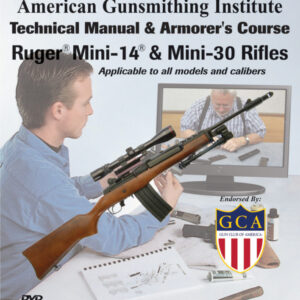Description
This video covers all of the hugely successful Ruger® Double Action revolvers since the Red Hawk was introduced in 1971. This means all that you need to know about the GP100®, SP101, Red Hawk, and Super Red Hawk revolvers are here in this superb course, taught by our Senior Instructor and Master Gunsmith Bob Dunlap.
If you want the quick course on how to get the worlds most overbuilt revolver apart, back together, clean and operating as intended, then this course is for you (if you want the long course, look into our basic 108 hour Professional Gunsmith Course.)
This course does not cover the first generation of Ruger® DA revolvers, the Security-Six®, Speed-Six®, and Police Six.
Among the items covered are:
History
- Discussion of the first Generation guns and Bill Ruger®s design philosophy
- Steady improvement in the design and performance of the second and third generation revolvers
- Why Ruger®s determination to improve the quality and performance of these guns instead of saving nickels and dimes with good enough shortcuts leads Bob to a surprising conclusion, and for him, amazing admission
- How Ruger®s mastery of the investment casting process and his high precision results enabled him to produce very high quality and durable revolvers at a low cost
Design & Function
- Discussion of the differences between the Ruger®, Colt, and Smith & Wesson cylinder locking systems, their strengths, and weaknesses
- Demonstration of the Ruger® locking system on the GP100® cut-a way
- Why the Ruger®s DA pull, like the S & W, does not stack like a Colt, the operation of the primary and secondary sear system
- Single action mechanism demonstrated
- The transfer bar operation is shown, how it works in the reverse of the S & W method
- How the hand works, where it lives, and why how fat it is, is as important as how tall it is
- How the hand works
- How the cylinder stop works
- What holds the yoke in place, a clever method
- Why they are way stronger than a Colt or S & W, but why they are more dangerous when they finally do blow
- Timing issues between bolt stop and hand
- Bob shows the answer to the question; what does the hand do and how does it do it
- Explanation and demonstration of the operation of the primary and secondary sears and the hammer cycle
- Explanation and demonstration of how the two hammer blocking safeties (side plate and rebound slide) work, and why if someone tells you “I dropped it and it fired,” they are lying
- Explanation and demonstration of the single action firing cycle with the side plate off
- Why the bolt also blocks the hammer with the cylinder pin out of its hole
- Cylinder lockup
- Evolution of the cylinder stop and hand over the past 50 years, five-screw frame and four-screw frame explained
- How changes in the side plate safety have evolved and its two most recent iterations
Disassembly
- The Red Hawk bares it all
- Extensive disassembly, parts not removed have removal described, including rear sight and trigger guard plunger
- Why it is a bad idea to remove the firing pin and bushing unless you have to in order to repair or replace it
- How the clever front sight retainer works
- A closer look at how the cylinder stop works
- Demonstration of the operation of the yoke plunger
- How the single hammer/trigger spring works, and its positives and negatives
- How to speed up cylinder stop timing, but what to be careful of
- How to make the special tool you will need to get the extractor out of the cylinder
Cleaning & Lubrication
- AGI cleaning & lubrication methods shown, along with the reasons for their use
Reassembly
- Making sure, you have no parts left over
- What you need a slave pin for (watch this first and make the pin ahead of time)
Final Thoughts
- Differences between the Red Hawk and GP100® guns explained, mainly separate trigger return and hammer springs
- How to completely disassemble the rear sight, and what to be careful to avoid
- Parts to smooth to improve feel and operation
If you noticed how often the terms explanation, demonstration, and shown are used, you may be getting some idea of why this course is necessary for any Ruger® Second and Third Generation revolver owner, or someone who intends to be.
View a sample of the content of this course below.
[youtube https://www.youtube.com/watch?v=JMehRuCQUU0]




